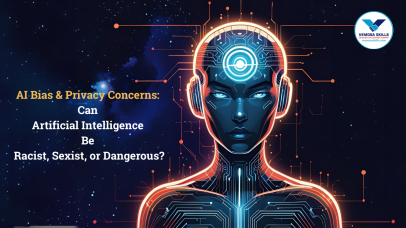AI Bias & Privacy Concerns: Can Artificial Intelligence Be Racist, Sexist, or Dangerous?
There is no doubt that AI has made our lives much easier. Things that used to take us hours or days to do are now happening in just a few seconds. AI has completely changed the way we work. It is not a revolution, but it is a revolution. But as AI evolves, it also brings with it some serious concerns that cannot be ignored, especially the issues of bias and privacy.
Minor concerns are fine, but the question is, can AI be racist, sexist, or even dangerous? In this blog today, we will understand why these issues matter, especially for students pursuing careers in AI, creative professionals using AI, and tech enthusiasts and businesses adopting AI solutions.
What is AI bias?
Understand AI bias in such a way that it refers to the way in which AI systems inadvertently perpetuate human biases. These biases arise when AI systems learn from data that is inaccurate or unrepresentative. Since AI relies on large datasets to “learn” patterns and make decisions, any inherent bias in that data can lead to biased results.
For example, if an AI system is trained on a dataset that primarily consists of white male faces, the AI system may have difficulty accurately identifying people with darker skin or women. And this is not because the AI has racial or gender bias, but because the data it learned from does not adequately represent real-world diversity.
Examples of AI bias in action:
- Facial recognition: A study found that most facial recognition systems are able to recognize facial features, to some extent, and the color of your face, but are not fully capable of recognizing facial color. This makes it a concern.
- Recruitment Algorithms: When people go for job interviews and submit their resumes to interviewers, the AI systems used for screening may be biased, i.e., these AI systems may inadvertently favor male candidates over female candidates due to historical data, resulting in gender inequality in recruitment processes.
Can AI be racist or sexist?
Yes, it is true that AI can indeed be racist or sexist. But at the same time, it is also important to understand that AI does not think like humans or have individual biases. AI systems are simply tools that rely on the data they are trained on. If the data reflects societal biases, whether racial, gender-based, or otherwise, the AI will replicate those biases.
Racism in AI:
To illustrate, when AI is used in criminal justice or surveillance systems, biased data can result in discriminatory outcomes. If an AI system is trained with data on historical police practices that have disproportionately targeted minority communities, the AI may recommend actions that disproportionately affect those same groups. This can lead to wrongful arrests or increased surveillance of people of color, exacerbating existing inequities.
Sexism in AI:
Just like racism, sexism in AI is a real issue. When screening interviews in any company, AI systems may overlook women’s skills and prioritize men. AI systems that recommend job candidates or screen resumes may not take into account gender-based language or historical biases present in the data, which can lead to fewer women being hired for leadership roles or in industries like technology.
Why does AI bias matter?
The simple answer to why AI bias matters is that it can exacerbate existing inequalities and perpetuate harmful stereotypes. If AI systems are not carefully monitored and corrected for bias, they can reinforce social, racial, and gender inequalities rather than challenge them. This can be a huge risk for us humans.
Now, take the case of Google’s AI-powered image recognition tool, which has faced criticism in the past for classifying pictures of Black people as gorillas. Although that problem was later resolved, it highlights how AI can perpetuate racist stereotypes when it is not trained properly and with enough care and representation.
We can understand this with another example, which is Amazon's hiring algorithm, which was found to be biased towards female candidates. This algorithm was trained on resumes submitted to the company over a period of 10 years, and you will be surprised that more resumes of men were selected here, due to which AI gave more preference to men for technical roles, which strengthened gender bias.
AI and Privacy Concerns
While AI bias is a serious issue, our privacy concerns are equally serious. AI systems often require large amounts of data to work. And this data can include sensitive and personal information. Now, whether it is through voice assistants like Siri or Alexa or through AI-powered ad targeting, AI systems are constantly collecting, storing, and analyzing our personal data, and it is very important for us to be aware of them.
The question arises: Who controls this data, and how is it being used?
Data Privacy Risks:
- Surveillance: You will be surprised to know that AI-powered surveillance systems can track our activities and even monitor our behavior, which can lead to potential violations of our privacy. Let me tell you that in countries where surveillance of citizens is used, AI can be a tool of authoritarian control.
- Social media and targeted advertising: Whenever you see anything on social media and like, comment, or share it, or do any kind of online interaction, the AI system of that platform understands your behavior or interest and then shows you ads according to your interest. This makes it clear that companies have access to a lot of your data, which can be used by manipulating it for advertising or political influence, as was once seen in the Cambridge Analytica scandal.
How can AI be dangerous?
The potential dangers of AI go beyond bias and privacy. When left unchecked, AI can have serious consequences for our future:
1. Autonomous weapons: AI-powered military technology is being developed, including drones that can decide who to target. Without human oversight, these systems can be used recklessly, causing harm or escalating conflicts that we cannot predict.
2. AI in healthcare: In medicine, AI systems are used to analyze patient data and aid in diagnosis. However, AI tools that have not been properly tested or trained with diverse datasets can make incorrect decisions, especially for patients from minority groups, leading to misdiagnosis or incorrect treatment.
3. Deepfakes: Deepfakes, generated by AI—videos or audio clips that can mimic real ones—can be used to create misleading or harmful content. This can lead to misinformation, manipulation, or even defamation.
How to Address AI Bias and Privacy Concerns
Fortunately, there are steps we can take to reduce the risks associated with AI:
1. Diverse and representative data: The best way to reduce AI bias is to ensure that the data used to train AI systems is diverse and representative. This means collecting data from a broad spectrum of people, backgrounds, and experiences to ensure that AI works fairly for everyone.
2. Transparency and accountability: Companies that develop AI systems should be transparent about how their systems work and how they use data. Users should have the ability to understand how AI makes decisions the way it does and be able to opt out of certain data collection practices if desired.
3. Ethical AI development: AI should be developed with ethics in mind. Companies and researchers should take into account the potential societal impact of AI and consider both the benefits and risks. AI developers should work to eliminate bias and discrimination in their algorithms and be accountable for any negative consequences caused by their systems.
4. Government regulation: Governments and international bodies should establish rules and guidelines for AI development and use. This includes ensuring that AI systems respect privacy rights, do not perpetuate harmful biases, and are transparent in their operations.
5. Human oversight: Even though AI can automate many tasks, it is vital that humans remain in the loop when it comes to making critical decisions. AI should complement human judgment, not replace it entirely, especially in sectors such as healthcare, law enforcement, and defense.
Conclusion
AI has the potential to transform industries, improve lives, and solve complex problems. However, as we have seen, it also brings serious concerns about bias and privacy. AI can reflect and amplify societal biases, becoming racist, sexist, or discriminatory if not managed carefully. Additionally, privacy risks associated with data collection and surveillance need to be addressed.
For students looking to enter the AI field, creatives using AI, tech enthusiasts, and businesses adopting AI, understanding these challenges is essential. It is not enough to simply develop AI technologies; we must also ensure they are developed ethically, transparently, and inclusively.
By focusing on diverse data, ethical development, transparency, and proper regulation, we can create AI systems that work fairly for everyone, minimizing the risks of bias and privacy violations while maximizing AI’s potential to drive positive change. The future of AI should be one where technology empowers people, not harms them.





